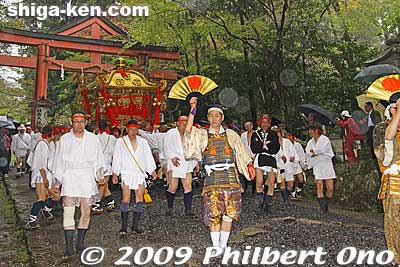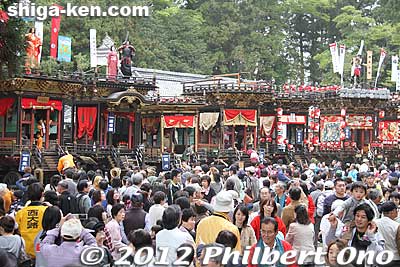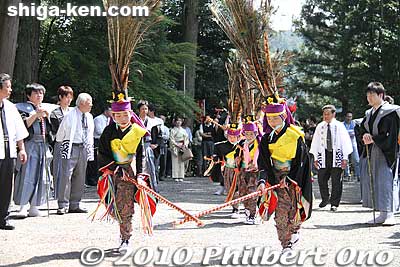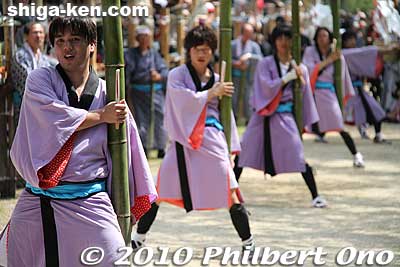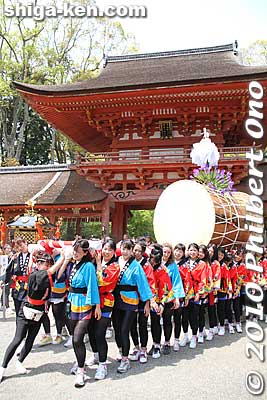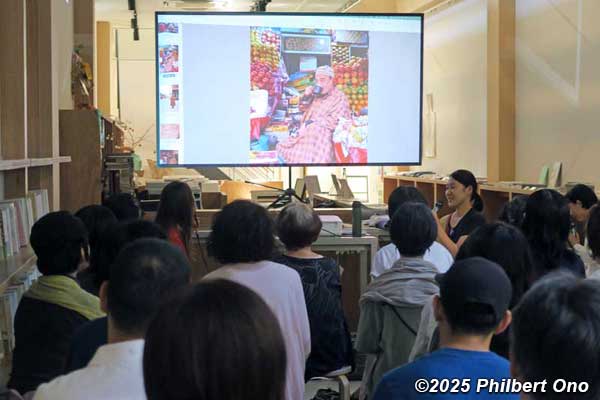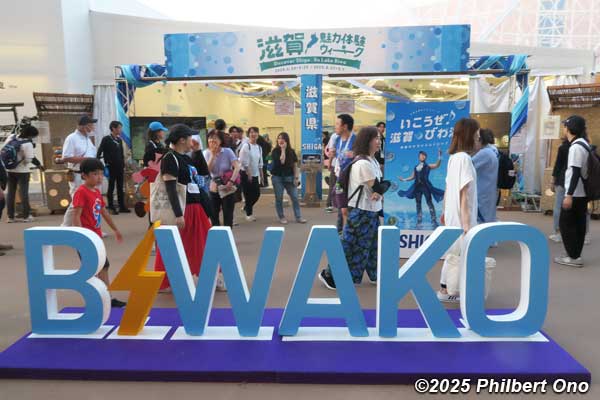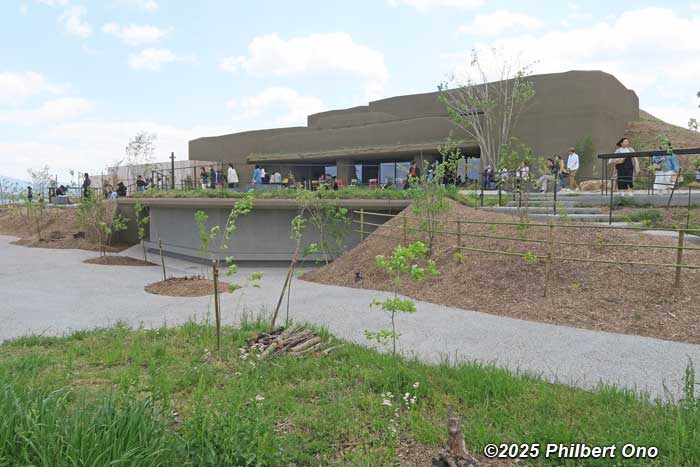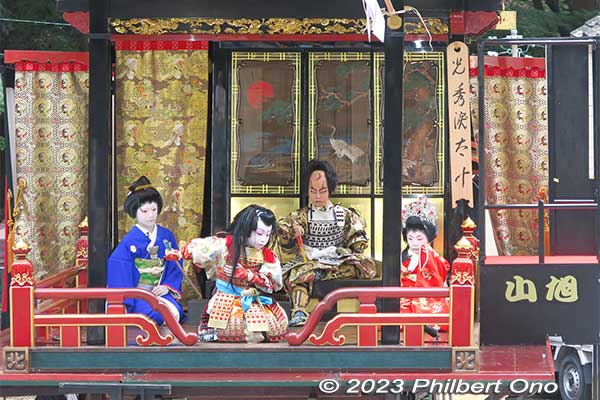Updated: Aug. 2, 2025
April is a great month. Soon after the onslaught of cherry blossoms, we have an onslaught of festivals (matsuri). This is the time to go out and celebrate the coming of spring, pray for good harvests, and see the traditional splendor of Shiga. The highest number of matsuri are held during these two months, especially during the string of national holidays in late April and early May called Golden Week. During the Golden Week holidays, Shiga has multiple festivals on the same day.
To make it easier to decide which ones to see, I’ve picked Shiga Prefecture’s Top 10 Festivals for April-May. I ranked them based on scale (number of participants, length of festival, etc.), grandioseness, cultural importance/significance, cultural perpetuation and practice for younger generations, uniqueness, and enjoyment by spectators.
1. Nagahama Hikiyama Matsuri, Nagahama Hachiman Shrine, Nagahama, April 15
Deciding Shiga’s No. 1 spring festival was a toss-up between the Nagahama Hikiyama Matsuri and Sanno-sai (No. 2 below). But I gave the edge to the Hikiyama Matsuri because it centers on passing on a traditional art to kids. Young boys undergo weeks-long rigorous training in voice and acting to put on a kabuki play during the festival. Out of 12 kabuki floats, festival features four ornate kabuki floats (hikiyama) with a small stage for authentic kabuki plays performed by grade school boys. Even if you cannot understand what they are saying, just looking at their makeup, costumes, and acting will delight. The kabuki performances start at the shrine at 10 am. Then the floats are pulled to other spots across central Nagahama (Otemon-dori shopping arcade) where the boys perform again. By the evening, all the floats gather at the Otabisho across town (near Hokoku Shrine) for more revelry until 9:30 pm when it ends. Although it gets crowded in front of the float, you can usually see the kabuki actors because they are elevated on the float. Although April 15 is the main festival day, they also have other festival events on adjacent days (see festival schedule here) and kabuki is performed on April 13, 14, 15, and 16 as well. My video | Google Map
2. Sanno-sai Festival, Hiyoshi Taisha Shrine, Otsu, April 12-15
Held by Hiyoshi Taisha Shrine in western Otsu at the foot of Mt. Hiei. This is perhaps Shiga Prefecture’s largest festival in terms of participants and the number of events. Held over a few days, you can see diverse events and rituals like an evening torch procession, thunderous rocking of portable shrines, and even a boat procession on the lake. One thing I like is the joint cooperation of Shinto and Buddhist priests in the ceremonies. You can see and hear both Shinto priests and Tendai Buddhist priests from Enryakuji temple praying or chanting at the same ceremony during the festival. So it’s not entirely a Shinto festival. Hiyoshi Taisha Shrine was historically affiliated with Enryakuji temple until the state required that Shinto and Buddhism be separate organizations. It’s up to you to decide which day and what time to see the festival. Click on the link above to see my photos of the festival (taken on April 13-15) to decide what you want to see. I saw and photographed all the major festival events except on the first day when they brought down the portable shrine from a low mountain. If it’s one festival that wore me out after three days, it’s this one. My video | Google Map
3. Nyu Chawan Matsuri, Nyu Shrine, Yogo (Nagahama), once every several years on May 4
Another of my all-time favorite festivals. They have three wooden floats topped with lofty “balancing act” chawan bowl decorations. They also hold beautiful sacred dances by boys dressed as girls. A procession of colorful flower umbrella dancers also provides a colorful accent to the festival. It’s held deep in a mountain valley of Yogo in northern Nagahama so the whole area is lush and peaceful. The only problem is that the festival is held only once every 5-6 years. The last time it was held was in 2009. According to rumors, the festival will be held in May 2014, next year. My video | Google Map
4. Hino Matsuri, Hino, May 3
Shiga has a good number of float festivals, but one of the grandest ones in spring is the Hino Matsuri. It’s grand because they have as many as 16 ornate floats with large wooden wheels that they pull through the main streets of Hino town. Each float belongs to a specific neighborhood in Hino and they are decorated with elaborate tapestries, paper lanterns, and a homemade paper sculpture on the roof that changes every year. They also have side attractions like a portable shrine procession and ceremonies featuring a sacred dance. From the morning, the floats are pulled along the streets to gather at Umamioka Watamuki Shrine, the center of the action. They play festival music and show off their floats. If you have time, you should also visit Shakunage Gorge, famous for rhododendron growing in a scenic gorge. There are lovely nature walking paths. Buses run from Hino Station. My video | Google Map
5. Higashi-Omi Giant Kite Festival (formerly Yokaichi Giant Kite Festival) (Odako Matsuri), Higashi-Omi, last Sun. in May.
*Update: The Higashiomi Odako Giant Kite Festival will likely restart in 2026 after being suspended since the tragic kite crash in May 2015. In June 2025, the Higashi-Omi municipal government approved a subsidy of ¥1 million to build a giant kite for the Giant Kite Festival.
The giant kite, made of washi paper and a bamboo frame, measures about 13 meters by 12 meters (size of 100 tatami mats) and weighs 700 kg. It is a work of art with a distinct shape, cutouts, and paint job featuring a traditional design of a large kanji character and twin animals. The design is selected from entries from the public and a new giant kite with a new design is made every three years. The public is also invited to help build the new kite every three years during the summer. On the festival day, the kite is flown on a riverbank a few times. It usually doesn’t stay aloft for very long unless there are strong winds. It can even crash so they clear the whole area whenever they fly the kite. You can also sign up to pull the kite. I did it once and they run at full speed. Kind of scary because if you trip and fall, you might get trampled. From 2013, the festival site shifted to the Fureai Undo Park in Notogawa. Free shuttle buses will run from Notogawa Station. After (or before) the festival, be sure to check out the Odako Kaikan Giant Kite museum. Shuttle buses run to the museum. My video | Google Map
6. Kenketo Matsuri, Koka (Tsuchiyama), May 3
Held at Takigi Jinja Shrine (龍樹神社), Kenketo Odori is a dance performed by eight boys aged 7 to 12. First there’s a procession to the shrine, and the boys start dancing at the shrine at around 2 pm. The dance was originally started to ward off calamities. The boys wear tall peacock feathers on their heads. The dance is a National Intangible Folk Cultural Property. The festival has an interesting twist when the crowd rushes to the man (sometimes knocking him down) holding a flower basket to take all the flowers. To get to the shrine, get off Kibukawa Station (JR Kusatsu Line and Ohmi Railways) and catch the Aikuru Bus. Get off at Higashi Maeno. The shrine is a short walk toward the river. My video | Google Map
7. Shichikawa Matsuri, Takashima, May 4
The largest festival in western Shiga is held at Oarahiko Shrine. It features a yakko-furi (samurai laborers) procession, yabusame horse runs, and portable shrine procession. The shrine is nearest to Shin-Asahi Station (JR Kosei Line). If it’s too far to walk, you can rent a bicycle at the train station. My video | Google Map
8. Hyozu Matsuri, Hyozu Taisha Shrine, Yasu, May 5
I call this Shiga’s best portable shrine festival. Over 35 portable srhines (mikoshi) are carried around Hyozu Taisha Shrine in a very lively and gregarious style. Two of the mikoshi are carried by all women called “Ayame,” meaning iris flowers. They wear colorful happi coats to carry the mikoshi. The only thing is that the gravel path can kick up dust. Best to watch the festival from upwind. A few foreigners also participate. It starts in the morning and ends in mid-afternoon. My video | Google Map
9. Hachiman Matsuri, Himure Hachimangu Shrine, Omi-Hachiman, April 14
Shiga’s biggest fire festival featuring several tall straw torches (as high as 10 meters) that are lit from 8 pm. If you have time during the day, you should come and look at the torches which are great works of art. The festival is prayer for an abundant harvest. They light the torches one by one. This festival is usually billed together with the Sagicho Matsuri another fire festival held in March. Sagicho Matsuri is still my favorite festival in Omi-Hachiman. My video | Google Map
10. Taga Matsuri, Taga Taisha Shrine, Taga, April 22
If you like horses and traditional costumes, see this festival. They have a long procession featuring Shinto priests, children in costume, women warriors, and more people on 40 horses. A total of 500 people are in the procession. There is a morning procession leaving Taga Taisha at 10:30 am for Totonomiya Shrine deep in Taga’s countryside, and an afternoon (main) procession leaving Taga Taisha at 2 pm for the Otabisho, a short distance away from Taga Taisha. Walkable from Taga Taisha-mae Station. My video | Google Map
For other spring festivals in Shiga, see my previous posts: April 2012 | May 2011 | May 2010 | 2009 Chawan Matsuri
